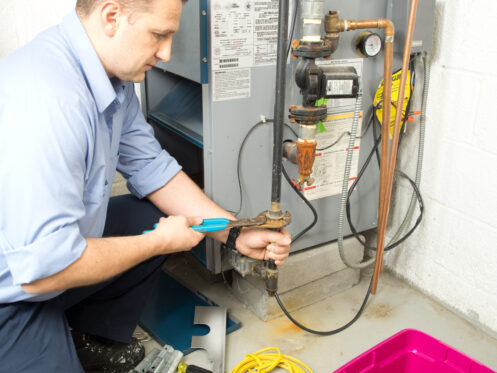There is a wide variety of available heating options when building a new home or upgrading your existing HVAC system. This is especially true when it comes to energy efficiency and heating effectiveness. In terms of both aspects, a dual-fuel heating system can be one of the very best options. Learn more about dual-fuel heating systems and why one of these systems may be the perfect fit for your home.
What Is a Dual-Fuel Heating System?
A dual-fuel heating system is a type of hybrid HVAC system that consists of both a gas furnace and an electric heat pump. Calling this type of system a heating system is slightly misleading since the heat pump part of the system also allows it to provide air conditioning. This is because heat pumps can operate in reverse so that they can take heat out of the home to cool it in addition to bringing heat inside to keep it warm.
Why Dual-Fuel Systems Are Sometimes Necessary
Although heat pump systems are extremely efficient and almost always use much less energy than all other heating systems, they do have a few limitations. One is that the energy efficiency of a heat pump usually decreases in temperatures below 40 degrees, and it continues to decrease even further the colder it gets.
Heat pumps also heat less effectively in colder temperatures since colder air contains less heat energy for them to capture and bring inside. In temperatures around or below freezing, many heat pump systems can only raise the temperature inside the home by 1 to 2 degrees per hour.
To effectively capture heat from outside and bring it into the building, a heat pump also needs to make the refrigerant extremely cold. This leads to any type of heat pump occasionally freezing up even when the outdoor temperature is well above freezing simply because the refrigerant is so cold, and condensation naturally forms on the unit’s coil. As a result, a heat pump will occasionally need to defrost any time it is heating and the outdoor temperature is around 40 degrees or below.
The only way a heat pump can defrost is to change over to run in cooling mode. This means the system starts pulling heat out of the home so that it can then pump hot refrigerant into the heat pump condenser outside to thaw it out. The fact that a heat pump will need to occasionally defrost is why almost all heat pump systems require some type of auxiliary or backup heating. If there wasn’t some type of backup heating, the temperature in the home would quickly drop when the heat pump was defrosting since the system is actively pulling heat out of the home.
How Dual-Fuel Heating Systems Work
All of these limitations are less pronounced in Southern California since our winters generally don’t get all that cold. Nonetheless, backup heating can still occasionally be required any time the heat pump is defrosting or whenever the home is more than a few degrees colder than your desired temperature. This is where a dual-fuel system can come in handy since the furnace serves as the backup heating source.
In warmer climates like California, a dual-fuel heating system will use the heat pump for heating most of the time. However, the gas furnace will automatically run whenever the heat pump defrosts. It will also run if your home is much colder, and it is taking the heat pump too long to raise the temperature in your house. In this case, it will run alongside the heat pump so that your heating system brings your home up to temperature much more quickly. The furnace will then shut off once your home is within 1 to 2 degrees of your desired temperature. The furnace in a dual-fuel system also serves as an emergency backup just in case the heat pump suddenly has any issues that prevent it from either running or heating effectively.
Advantages of a Dual-Fuel Heating System
Many modern heat pump systems have a different type of backup or auxiliary heat source in the form of electric heat strips that are installed within the air handler compartment inside the home. The problem with this is that electric heat strips are notorious for using lots of energy. Any time the heat strips are on, they will typically lead to the heating system using at least three times more energy than it would when just the heat pump is running.
This is one area where a dual-fuel system has a major advantage since the furnace in this type of system will also use much less energy than electric heat strips and help to keep your heating costs a bit lower. This is partly because gas furnaces simply use less energy. It is also because they put out far more heat compared, which means the furnace in a dual-fuel system generally won’t ever run nearly as long as electric heat strips would. Another reason that a dual-fuel system will typically cost less to operate when running on auxiliary heat is that natural gas rates are usually quite a bit lower than electricity rates.
Another major advantage of choosing a dual-fuel heating system is that the furnace will ensure that your home still has heat any time your power goes out. This obviously isn’t the case with a system that relies on electric heat strips as the backup heat source. This fact is especially important in California considering that blackouts and power outages are becoming increasingly more common and can sometimes last for days.
Disadvantages of Dual-Fuel Heating Systems
The main drawback to dual-fuel heating systems is that they cost quite a bit more to install compared to a standard heat pump system. In most cases, you’re looking at spending at least a few thousand dollars more for a dual-fuel system than you would for just a standard heat pump system.
Modern heat pump systems are also much more effective in cold weather, which means you would rarely need to rely on the backup heat source in California no matter what type it is. With a dual-fuel system, you’ll also need to have both the heat pump and furnace maintained annually and repaired as needed instead of just having to deal with one unit. These issues don’t mean that a dual-fuel heating system is a bad choice, but they’re still definitely worth keeping in mind when choosing which type of heating system to install.
Riverside’s Heating and Air Conditioning Experts
Sheldon's Heating, Air Conditioning & Plumbing is the HVAC contractor you can trust if you need to install a new heating or air conditioning system in the Riverside area. As a Carrier Authorized Dealer, we offer an extensive selection of heating and air conditioning units, and our team can help you decide if a dual-fuel system is right for your home. Our commitment to excellence has allowed us to earn the prestigious Carrier President’s Award. Whether you need to replace your HVAC system or need any heating or AC repairs or maintenance, give us a call to receive the expert help and advice your family deserves.




